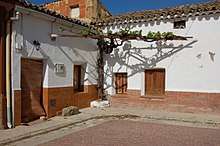Vitis
Vitis (grapevines) is a genus of 79 accepted species[5] of vining plants in the flowering plant family Vitaceae. The genus is made up of species predominantly from the Northern hemisphere. It is economically important as the source of grapes, both for direct consumption of the fruit and for fermentation to produce wine. The study and cultivation of grapevines is called viticulture.
Most Vitis varieties are wind-pollinated with hermaphroditic flowers containing both male and female reproductive structures. These flowers are grouped in bunches called inflorescences. In many species, such as Vitis vinifera, each successfully pollinated flower becomes a grape berry with the inflorescence turning into a cluster of grapes. While the flowers of the grapevines are usually very small, the berries are often large and brightly colored with sweet flavors that attract birds and other animals to disperse the seeds contained within the berries.[6]
Grapevines usually only produce fruit on shoots that came from buds that were developed during the previous growing season. In viticulture, this is one of the principles behind pruning the previous year's growth (or "One year old wood") that includes shoots that have turned hard and woody during the winter (after harvest in commercial viticulture). These vines will be pruned either into a cane which will support 8 to 15 buds or to a smaller spur which holds 2 to 3 buds.[6]
Biology

Flower buds are formed late in the growing season and overwinter for blooming in spring of the next year. They produce leaf-opposed cymes. Vitis is distinguished from other genera of Vitaceae by having petals which remain joined at the tip and detach from the base to fall together as a calyptra or 'cap'. The flowers are mostly bisexual,[7]:143 pentamerous, with a hypogynous disk. The calyx is greatly reduced or nonexistent in most species and the petals are joined together at the tip into one unit but separated at the base. The fruit is a berry, ovoid in shape and juicy, with a two-celled ovary each containing two ovules, thus normally producing four seeds per flower (or fewer by way of aborted embryos).[8]
Other parts of the vine include the tendrils which are leaf-opposed, branched in Vitis vinifera, and are used to support the climbing plant by twining onto surrounding structures such as branches or the trellising of a vine-training system.
In the wild, all species of Vitis are normally dioecious, but under domestication, variants with perfect flowers appear to have been selected.
The genus Vitis is divided into two subgenera Euvitis Planch. have 38 chromosomes (n=19) with berries borne on clusters[9] and Muscadinia Planch. 40 (n=20) with small custers.[10][11]
Species

Most Vitis species are found in the temperate regions of the Northern Hemisphere in North America and Asia with a few in the tropics. The wine grape Vitis vinifera originated in southern Europe and southwestern Asia. The species occur in widely different geographical areas and show a great diversity of form.
Their growth makes leaf collection challenging and polymorphic leaves make identification of species difficult. Mature grapevines can grow up to 48 cm in diameter at breast height and reach the upper canopy of trees more than 35 m in height.[12]
Many species are sufficiently closely related to allow easy interbreeding and the resultant interspecific hybrids are invariably fertile and vigorous. Thus the concept of a species is less well defined and more likely represents the identification of different ecotypes of Vitis that have evolved in distinct geographical and environmental circumstances.
The exact number of species is not certain, with species in Asia in particular being poorly defined. Estimates range from 40 to more than 60.[13] Some of the more notable include:
- Vitis arizonica, The Arizona grape is native to Arizona, Utah, Nevada, California, New Mexico, Texas, and Northern mexico.[14]
- Vitis vinifera, the European grapevine. Native to the Mediterranean and Central Asia.
- Vitis labrusca, the fox grapevine, sometimes used for winemaking and for jam. Native to the Eastern United States and Canada. The Concord grape is a common cultivar.
- Vitis riparia, the riverbank grapevine, sometimes used for winemaking and for jam. Native to the entire Eastern U.S. and north to Quebec.
- Vitis aestivalis, the summer grape, native to the Eastern United States, especially the Southeastern United States.
- Vitis rotundifolia (syn. Muscadinia rotundifolia), the muscadine, used for jams and wine. Native to the Southeastern United States from Delaware to the Gulf of Mexico.
- Vitis rupestris, the rock grapevine, used for breeding of Phylloxera resistant rootstock. Native to the Southern United States.
- Vitis coignetiae, the crimson glory vine, a species from East Asia grown as an ornamental plant for its crimson autumn foliage.
- Vitis amurensis, native to the Asian continent, including parts of Siberia and China.
- Vitis vulpina, the frost grape, native to the Eastern United States, from Massachusetts to Florida, and west to Nebraska, Kansas, and Texas.[15] Treated by some as a synonym of V. riparia.[16]
- Vitis californica, the California wild grape, or Northern California grape, or Pacific grape, is a wild grape species widespread across much of California as well as southwestern Oregon.
There are many cultivars of grapevines; most are cultivars of V. vinifera.
Hybrid grapes also exist, and these are primarily crosses between V. vinifera and one or more of V. labrusca, V. riparia or V. aestivalis. Hybrids tend to be less susceptible to frost and disease (notably phylloxera), but wine from some hybrids may have a little of the characteristic "foxy" taste of V. labrusca.
The Latin word Vitis has feminine grammatical gender,[17] and therefore species names with adjectival specific epithets take feminine forms, such as V. vinifera.[18][lower-alpha 1]
Uses
The fruit of several Vitis species are grown commercially for consumption as fresh grapes and for fermentation into wine. Vitis vinifera is the most important such species.
The leaves of several species of grapevine are edible and are used in the production of dolmades and Vietnamese lot leaves.
Commercial distribution

According to the "Food and Agriculture Organization" (FAO), 75,866 square kilometres of the world is dedicated to grapes. Approximately 71% of world grape production is used for wine, 27% as fresh fruit, and 2% as dried fruit. A portion of grape production goes to producing grape juice to be used as a sweetener for fruits canned "with no added sugar" and "100% natural". The area dedicated to vineyards is increasing by about 2% per year.
The following list of top wine-producers shows the corresponding areas dedicated to grapes (regardless of the grapes’ final destination):[20]
| Country | Area under vine (ha x103) | Grape production (metric ton x106) |
|---|---|---|
| World | 7511 | 75.7 |
| | 1021 | 6.0 |
| | 830 | 12.6 |
| | 786 | 6.3 |
| | 682 | 8.2 |
| | 497 | 3.6 |
| | 419 | 7.0 |
| | 225 | 2.4 |
| | 223 | 2.1 |
| | 217 | |
| | 211 | 3.1 |
| | 192 | |
| | 149 | 1.7 |
| | 140 | |
| | 130 | 2.0 |
| | 120 | 2.6 |
| | 85 | 1.5 |
| | 60 | |
| | 39 |
Domestic cultivation
Grapevines are widely cultivated by gardeners, and numerous suppliers cater specifically for this trade. The plants are valued for their decorative foliage, often colouring brightly in autumn; their ability to clothe walls, pergolas and arches, thus providing shade; and their fruits, which may be eaten as dessert or provide the basis for homemade wines. Popular varieties include:-
- Buckland Sweetwater' (white dessert)
- 'Chardonnay' (white wine)
- 'Foster's Seedling' (white dessert)
- 'Muscat of Alexandria' (white dessert)
- 'Müller-Thurgau' (white wine)
- 'Phoenix' (white wine)
- 'Pinot noir' (red wine)
- 'Regent' (red wine)
- 'Schiava Grossa' (red dessert)
- 'Seyval blanc' (white wine)[21]
The following varieties have gained the Royal Horticultural Society's Award of Garden Merit:-[22]
- 'Brant'[23] (black dessert)
- 'New York Muscat'[24] (black dessert)
- 'Purpurea'[25] (ornamental)
- Vitis coignetiae[26] (ornamental)
Pests and diseases

Phylloxera is an American root aphid that devastated V. vinifera vineyards in Europe when accidentally introduced in the late 19th century. Attempts were made to breed in resistance from American species, but many winemakers didn't like the unusual flavour profile of the hybrid vines. However, V. vinifera grafts readily onto rootstocks of the American species and their hybrids with V. vinifera, and most commercial production of grapes now relies on such grafts.
The black vine weevil is another root pest.
Grapevines are used as food plants by the larvae of some Lepidoptera species - see list of Lepidoptera that feed on grapevines.
Symbolism
The grapevine (typically Vitis vinifera) has been used as a symbol since ancient times. In Greek mythology, Dionysus (called Bacchus by the Romans) was god of the vintage and, therefore, a grapevine with bunches of the fruit are among his attributes. His attendants at the Bacchanalian festivals hence had the vine as an attribute, together with the thyrsus, the latter often entwined with vine branches. For the same reason, the Greek wine cup (cantharos) is commonly decorated with the vine and grapes, wine being drunk as a libation to the god.
In Christian iconography, the vine also frequently appears. It is mentioned several times in the New Testament. We have the parable of the kingdom of heaven likened to the father starting to engage laborers for his vineyard. The vine is used as symbol of Jesus Christ based on his own statement, “I am the true vine (John 15:1).” In that sense, a vine is placed as sole symbol on the tomb of Constantia, the sister of Constantine the Great, and elsewhere. In Byzantine art, the vine and grapes figure in early mosaics, and on the throne of Maximianus of Ravenna it is used as a decoration.
The vine as symbol of the chosen people is employed several times in the Old Testament. The vine and wheat ear have been frequently used as symbol of the blood and flesh of Christ, hence figuring as symbols (bread and wine) of the Eucharist and are found depicted on ostensories. Often the symbolic vine laden with grapes is found in ecclesiastical decorations with animals biting at the grapes. At times, the vine is used as symbol of temporal blessing.[27]
References
Notes
- -fer is an adjectival suffix, with forms -fer (M), -fera (F), and -ferum (N).[19]
Citations
- "PLANTS Profile for Vitis (grape)". USDA. Retrieved November 16, 2009.
- GRIN. "Species in GRIN for genus Vitis". Taxonomy for Plants. National Germplasm Resources Laboratory, Beltsville, Maryland: USDA, ARS, National Genetic Resources Program. Archived from the original on September 24, 2015. Retrieved April 20, 2010.
- V. kelungensis, V. yeshanensis Ahmet Güner; =Gábor Gyulai; Zoltán Tóth; Gülsüm Asena Başlı; Zoltán Szabó; Ferenc Gyulai; András Bittsánszky; Luther Waters Jr.; László Heszky (2008). "Grape (Vitis vinifera) seeds from Antiquity and the Middle Ages Excavated in Hungary - LM and SEM analysis" (PDF). Anadolu Univ J Sci Technol. Archived from the original (PDF) on October 23, 2012. Retrieved May 23, 2010.
- "The Plant List: A Working List of All Plant Species". Retrieved July 9, 2015.
- "The Plant List: Vitis". Royal Botanic Gardens, Kew. 2013.
- Wine & Spirits Education Trust "Wine and Spirits: Understanding Wine Quality" pgs 2-5, Second Revised Edition (2012), London, ISBN 9781905819157
- Stace, C. A. (2010). New Flora of the British Isles (Third ed.). Cambridge, U.K.: Cambridge University Press. ISBN 9780521707725.
- Gleason and Cronquist volume 2, New Britton and Brown Illustrated Flora of the Northeastern United States and Adjacent Canada, p. 517. LCCN 63-16478
- Bennett, M.D.; Leitch, I.J. (2012). "Royal Botanic Gardens, Kew: Plant DNA C-values database, release 6.0". Royal Botanic Gardens, Kew. Archived from the original on 2016-03-19. Retrieved 2016-04-02.
- "Vitis rotundifolia Muscadine Grape, Scuppernong". Plant of the Week: Vitis rotundifolia Muscadine Grape, Scuppernong. University of Arkensas. Retrieved 2019-08-06.
- Lu, Jiang; Lamikanra, Olusola (1996). "Barriers to Intersubgeneric Crosses between Muscadinia and Euvitis". HortScience. American Society for Horticultural Science. 31 (2): 269–271. doi:10.21273/hortsci.31.2.269. ISSN 0018-5345.
- Everhart SE (2010). "Upper Canopy Collection and Identification of Grapevines (Vitis) from Selected Forests in the Southeastern United States". Castanea (From University of Nebraska Digital Commons). 75 (1): 141–149.
- Galet, Pierre (2000). Dictionnaire encyclopédique des cépages. Hachette Pratique. ISBN 2-01-236331-8.
- http://swbiodiversity.org/seinet/taxa/index.php?taxauthid=1&taxon=3578&clid=25#
- "PLANTS Profile for Vitis vulpina (snow grape)". USDA. Retrieved November 16, 2009.
- Jain, E.; Bairoch, A.; Duvaud, S.; Phan, I.; Redaschi, N.; Suzek, B.E.; Martin, M.J.; McGarvey, P.; Gasteiger, E. (November 3, 2009). "Vitis riparia (Frost grape) (Vitis vulpina)". The Universal Protein Resource (UniProt). The UniProt Consortium. Retrieved November 16, 2009.
- Lewis, C.T.; Short, C. (1958), A Latin Dictionary, Oxford: Clarendon Press
- McNeill, J.; Barrie, F.R.; Buck, W.R.; Demoulin, V.; Greuter, W.; Hawksworth, D.L.; Herendeen, P.S.; Knapp, S.; Marhold, K.; Prado, J.; Prud'homme Van Reine, W.F.; Smith, G.F.; Wiersema, J.H.; Turland, N.J. (2012), International Code of Nomenclature for algae, fungi, and plants (Melbourne Code) adopted by the Eighteenth International Botanical Congress Melbourne, Australia, July 2011, Regnum Vegetabile 154, A.R.G. Gantner Verlag KG, ISBN 978-3-87429-425-6 Article 23.5
- Stearn, W.T. (1992), Botanical Latin: History, grammar, syntax, terminology and vocabulary, Fourth edition, David and Charles
- "OIV Statistical Report on World Vitiviniculture 2016" (PDF). Retrieved 7 September 2017.
- Klein, Carol (2009). Grow your own fruit. United Kingdom: Mitchell Beazley. p. 224. ISBN 9781845334345.
- "AGM Plants - Ornamental" (PDF). Royal Horticultural Society. July 2017. p. 107. Retrieved 18 February 2019.
- "RHS Plant Selector - Vitis 'Brant '". Retrieved 1 June 2013.
- "RHS Plant Selector - Vitis 'New York Muscat'". Retrieved 1 June 2013.
- "RHS Plant Selector - Vitis 'Purpurea'". Retrieved 1 June 2013.
- "RHS Plant Selector Vitis coignetiae". Retrieved 1 June 2013.
-

Sources
Further reading
- Francesco Emanuelli; Silvia Lorenzi; Lukasz Grzeskowiak; Valentina Catalano; Marco Stefanini; Michela Troggio; Sean Myles; José M. Martinez-Zapater; Eva Zyprian; Flavia M. Moreira & M. Stella Grando (2013). "Genetic diversity and population structure assessed by SSR and SNP markers in a large germplasm collection of grape". BMC Plant Biology. BioMed Central Ltd. 13: 39. doi:10.1186/1471-2229-13-39. PMC 3610244. PMID 23497049.
- Roberto Bacilieri; Thierry Lacombe; Loic Le Cunff; Manuel Di Vecchi Staraz; Valerie Laucou; Blaise Genna; Jean-Pierre Peros; Patrice This; Jean-Michel Boursiquot (2013). "Genetic structure in cultivated grapevines is linked to geography and human selection". BMC Plant Biology. BioMed Central Ltd. 13: 25. doi:10.1186/1471-2229-13-25. PMC 3598926. PMID 23394135.
External links


- List of 48 descriptors defined in the GRAPEGEN06 project (selected from the 151 OIV descriptors published in June 2007)

